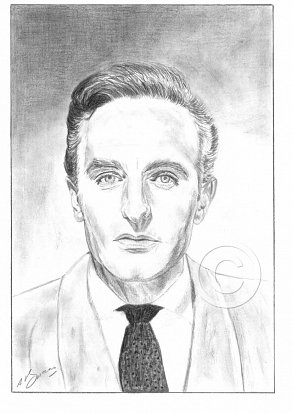Anton Diffring
Pencil Portrait by Antonio Bosano.

Shopping Basket
The quality of the prints are at a much higher level compared to the image shown on the left.
Order
A3 Pencil Print-Price £20.00-Purchase
A4 Pencil Print-Price £15.00-Purchase
*Limited edition run of 250 prints only*
All Pencil Prints are printed on the finest Bockingford Somerset Velvet 255 gsm paper.
P&P is not included in the above prices.

Recommended viewing
Car Along the Pass (ITV 1977)
Henry Duckworth (Arthur Lowe) “from Twickenham Twickenham” is on a camping holiday in the Alps with his wife, Ethel. His British stiff upper lip and fortitude are called into action when the cable car they are travelling in comes to a sudden halt. Someone has to keep the passengers cheerful and he determines it to be his job – as an Englishman.
Anton Diffring is the rather aristocratic German who outranked Lowe throughout the war, much to Lowe’s disdain, which only serves to heighten his acute xenophobia. Having established their respective roles in the war – Lieutenant (Army Education Core) and pilot (Luftwaffe), Anton seeks to placate any rising hostility by gently whispering “I didn’t agree with the war.” Lowe, of course, is having none of it – “Oh no, none of you did when it was over. I haven’t met one. As a matter of fact, I don’t know how Hitler ever got an army together; there must have only ever have been a half a dozen of you.”
Galton and Simpson deliver another minor masterpiece around the theme of enforced confinement. It had served them well throughout two classic “Hancock’s Half Hour” – “The Train Journey” (1959) and “The Lift” (1961) and hear it provides a springboard for the undoubted talents of Arthur Lowe.
Today’s political snowflakes will be horrified at Henry’s outlook and beliefs. I simply laughed, for
there’s something inherently funny about ethnic diversity. Coming – as I do – from a mixed background, it’s blindingly apparent. The more people singularly fail to laugh at themselves, the funnier they are. In the final analysis, not all ethnic humour, racial and /or minority group humour is necessarily at the expense of the target group; indeed some of it may actually compliment the group.
Take the war in Afghanistan. The British and American forces were involved in really heavy fighting with the Taliban. The worst of the fighting was in and around the caves of Tora Bora. The American forces dubbed them, ‘The Caves of Death’. The British forces referred to them as, ‘Tora Bora Tomkinson’.
Let’s lighten up and embrace indigenous humour.


Comments
Anton Diffring, the actor famous for playing evil Nazis throughout his career, died on 20th May, 1989.
He was born – and here we first encounter some of the mystique surrounding this actor – either Alfred Pollack or Anton de Vient in Koblenz on October 20, 1916. His father was a Jewish store-owner, his mother a Christian. He reportedly fled his native Germany in 1939, just prior to the outbreak of World War II. Having trained as an actor in Berlin and Vienna, his career would be put on hold when he arrived in America. Interned as an “enemy alien,” he would return to the stage in Toronto in a production of Richard III.
Moving to the UK, he would find work in a series of films, beginning with State Secret (1950) but it was his first main role as a Nazi in the 1953 prison escape drama “Albert R.N.” that would establish the blueprint for his subsequent career.
Lamenting the professional confinement of the roles he was offered, but sagacious enough to take the accompanying money and security, Diffring continued to make the most of his blonde hair, blue eyes and chiselled features on both sides of the Atlantic, appearing in such classics as “The Colditz Story “(1955), “The Heroes of Telemark” (1965), “The Blue Max” (1966), “Where Eagles Dare” (1968),“Operation Daybreak” (1975 – as SS officer Reinhard Heydrich) and “Escape to Victory” (1981).
Running parallel to his celluloid war exploits, he also worked extensively for Hammer pictures, appearing in horror roles such as Dr Georges Bonnet in “The Man Who Could Cheat Death” (1959), Dr Schuler in “Circus of Horrors2 (1960) and Pavel in “The Beast Must Die” (1974). Diffring also worked in several international films, including François Truffaut’s “Fahrenheit 451” (1966).
He died in his home at Châteauneuf-Grasse in southern France, in 1989 and, while no official statement as to his cause of death was ever released, fellow German actor Arthur Brauss suggested, in a 2002 Terrorverlag interview, that he died from an AIDS related condition. However, in her biography of Diffring, author Susan Edwards states that he died of cancer.